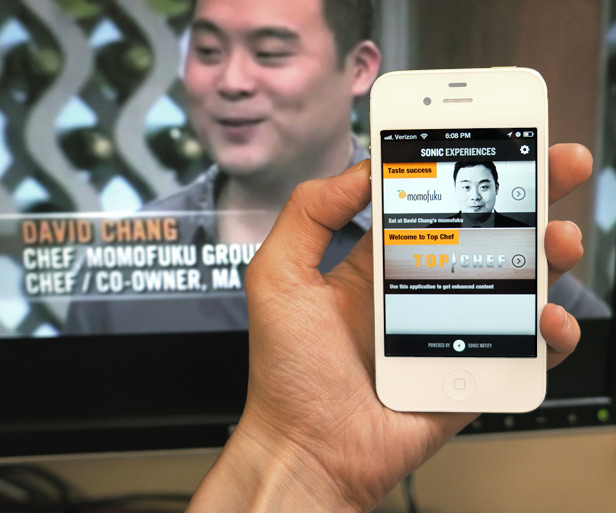Startup Sends More than Music through Speakers

In the not-so-distant future, you might be rocking out at a Katy Perry concert when your smart phone’s screen lights up with a sneak peek of the pop star’s new music video. Or perhaps you’ll be watching a police drama at home when your iPad lights up with clues about the identity of the serial killer being chased by the on-screen detectives.
At least, this is the hope of Alex Bell, cofounder of Sonic Notify, a company that offers technology to broadcast data to smart phones and tablets via high-frequency sound waves. Rather than trying to gain critical mass for its own smart phone app, Sonic Notify offers its software to developers so they can build it into theirs—a move that could also result in more creative uses for the technology than the company might come up with on its own.
“Any speaker in the world can serve as a transmitter. The sky’s the limit for what creative applications people can think of,” says Bell, who is also the inventor of Sonic Notify’s technology.
Sonic Notify isn’t the first to use sound waves to communicate with consumers on their smart phones—Shopkick, a shopping rewards app, for example, also uses audio signals in conjunction with in-store beacons and its own app to determine when a user is inside a shop.
As Bell explains it, though, Sonic Notify is more robust. Sonic Notify basically works like a one-way modem that sends little packets of data via sound that your smart phone microphone can pick up and an app can translate. The app can be configured to start sniffing for Sonic Notify content at specific times or when a user enters a certain geographic area (on the iPhone, though, a user would get an alert if an app started “listening” at a specific time).
For example, if a TV broadcaster wants to send out special content during the Super Bowl, it could use a computer running Sonic Notify’s software to add a sound wave including a stream of codes to its regular audio broadcast. The codes would be played every few seconds during the game. If you watch the game at home, a smart phone running a special Super Bowl app in the background could “hear” a code, and interpret it as instructions to start playing a specific YouTube video or, say, ask users to vote for the team they think will win.
Companies using Sonic Notify can upload their own content to Sonic Notify’s content management system, and that content will pop up on a smart phone running an enabled app when an inaudible Sonic Notify tone is played (either over regular speakers or ultrasonic beacons that Sonic Notify sells for several dollars). The Sonic Notify sound can be incorporated with prerecorded audio, such as a song, or delivered live at an event. Customers pay a fee depending on how much content they serve using Sonic Notify’s technology.
The technology has been built into several apps already, including one for pop artist Katy Perry (if users keep the feature turned on, the app promises to serve up content at events). And in New York in February, the Made Fashion Week app showed users additional information about looks that models were wearing on the runway—the data was broadcast to smart phones over the event’s sound system. Fashion buffs stuck at home with the app on their phones got a similar experience while watching a live stream of the event, Bell says.
Beyond apps, Bell envisions a number of uses for the technology. Sonic Notify beacons could be embedded in lanyards, he says, so when you’re at a business convention, you’d see the Twitter profiles of other attendees as you pass them. He also says the company is working with Muzak, a company that provides retailers with in-store audio, on bringing advertisers and Sonic Notify-enabled apps into shops.
But will people want to use it? Mark Beccue, an analyst at ABI Research, isn’t sure. “It’s true that people are sometimes using these devices while they’re watching something, but the trick’s going to be how engaged would they be with what you’re going to give them?” he asks. He thinks the idea is intriguing, but says monetizing it will be tough.
Investors think Sonic Notify has potential, though. The company is finalizing a $5 million series A round of funding. And Bell says Sonic Notify is bringing in revenue from companies that are using its software development kit in their apps. The company allows developers to send out a certain amount of content for free, and charges for each piece of unique content delivered beyond that.
Keep Reading
Most Popular
Large language models can do jaw-dropping things. But nobody knows exactly why.
And that's a problem. Figuring it out is one of the biggest scientific puzzles of our time and a crucial step towards controlling more powerful future models.
How scientists traced a mysterious covid case back to six toilets
When wastewater surveillance turns into a hunt for a single infected individual, the ethics get tricky.
The problem with plug-in hybrids? Their drivers.
Plug-in hybrids are often sold as a transition to EVs, but new data from Europe shows we’re still underestimating the emissions they produce.
Stay connected
Get the latest updates from
MIT Technology Review
Discover special offers, top stories, upcoming events, and more.